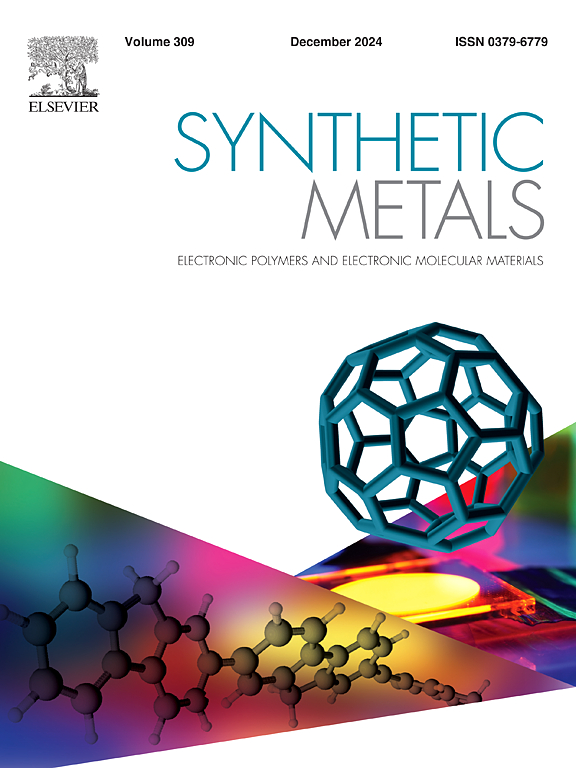Transparent conductive PEDOT–graphene films from large-flake graphite
IF 4.6
3区 材料科学
Q2 MATERIALS SCIENCE, MULTIDISCIPLINARY
引用次数: 0
Abstract
The demand for affordable, flexible, transparent, and robust thin film electrodes in organic electronics has highlighted the limitations of indium tin oxide (ITO), which suffers from fragility and high costs. Poly(3,4-ethylenedioxythiophene) (PEDOT), particularly when doped with poly(styrene sulfonate) (PSS), has emerged as a promising alternative due to its mechanical flexibility, electrical conductivity, and environmental stability. However, PSS's insulating nature, hygroscopicity, and acidity present significant drawbacks. This study explores an alternative approach using large-flake graphene, exfoliated through a solvent interface trapping method (SITM), as a conductive template for PEDOT polymerization. The resulting PEDOT-graphene films exhibit conductivities reaching 1070 S/cm, surpassing those of previously reported PEDOT-based films. The graphene sheets, acting as templates during vapor-phase polymerization (VPP) of PEDOT, enhance the film's conductivity by increasing electron pathways and crystalline regions within PEDOT. Characterization through SEM, TEM, XRD, Raman spectroscopy, XPS, and UV-Vis spectroscopy confirms the structural and electrical integrity of the films. Additionally, these films demonstrate potential applications in sensing technologies, particularly responsive to volatile organic compounds such as triethylamine. This work presents a scalable method for producing high-conductivity, transparent PEDOT-graphene films, offering a viable alternative to ITO in organic electronic applications.
透明导电pedot -石墨烯薄膜由大鳞片石墨制成
有机电子领域对价格合理、灵活、透明和坚固的薄膜电极的需求凸显了氧化铟锡(ITO)的局限性,即易碎性和高成本。聚(3,4-乙烯二氧噻吩)(PEDOT),特别是当掺杂聚(苯乙烯磺酸盐)(PSS)时,由于其机械柔韧性,导电性和环境稳定性,已成为一种有前途的替代品。然而,PSS的绝缘性、吸湿性和酸性存在明显的缺点。本研究探索了一种替代方法,使用大片状石墨烯,通过溶剂界面捕获法(SITM)剥离,作为PEDOT聚合的导电模板。所得的pedot -石墨烯薄膜的电导率达到1070 S/cm,超过了先前报道的pedot基薄膜。石墨烯片在PEDOT的气相聚合(VPP)过程中充当模板,通过增加PEDOT内的电子路径和晶体区域来增强薄膜的导电性。通过SEM, TEM, XRD,拉曼光谱,XPS和UV-Vis光谱表征,证实了膜的结构和电完整性。此外,这些薄膜展示了在传感技术中的潜在应用,特别是对挥发性有机化合物(如三乙胺)的反应。这项工作提出了一种可扩展的方法来生产高导电性、透明的pedot -石墨烯薄膜,为有机电子应用中的ITO提供了可行的替代品。
本文章由计算机程序翻译,如有差异,请以英文原文为准。
求助全文
约1分钟内获得全文
求助全文
来源期刊

Synthetic Metals
工程技术-材料科学:综合
CiteScore
8.30
自引率
4.50%
发文量
189
审稿时长
33 days
期刊介绍:
This journal is an international medium for the rapid publication of original research papers, short communications and subject reviews dealing with research on and applications of electronic polymers and electronic molecular materials including novel carbon architectures. These functional materials have the properties of metals, semiconductors or magnets and are distinguishable from elemental and alloy/binary metals, semiconductors and magnets.
 求助内容:
求助内容: 应助结果提醒方式:
应助结果提醒方式:


